Crew 215 Greenhab Report 16Nov2019
[title Greenhab Report – Nov 16th]
[category greenhab-report]
Crew 215 GreenHab Report 16-11-2019
GreenHab Officer: Guy Murphy
Environmental control: Door left open for ventilation 12 midday then reclosed at 3pm as
the day was overcast.
Average temperatures: –
Hours of supplemental light: Automatic system
Daily water usage for crops: 8 liters (1 full blue watering cans).
Daily water usage for research and/or other purposes:
Water in Blue Tank –
Time(s) of watering for crops: 8:30am.
Changes to crops: None. The soil remained moist all day, the weather being overcast.
SEASONAL PLANTING HISTORY
Established plants introduced 03/11/2019
[3x] strawberry plants (Everbearing), in medium metal planter
[1x] spicy orange thyme (thymus fragantissimus), small terra cotta pot
[1x] lemon balm scented geranium (pelargonium x Melissinum), small terra cotta pot
[1x] Mint Mentha – Berries & Cream, small terra cotta pot
[1x] Pineapple Mint – mentha suaveolens variegated, small terra cotta pot
[1x] Ice plant – Delospermo ‘jewel of the desert garnet’, small terra cotta pot
[1x] Sempervium textorum assorted Hen & Chicks, small terra cotta pot
[1x] Rosemary ‘Barbecue’ (Rosmarinus officinalis ‘Barbecue’), large plastic pot
[1x] Rosemary ‘Spice Island’ Rosmarinus officinalis ‘Spice Island’, large plastic pot
[1x] mint, grapefruit, large plastic pot
[2x] small Aloe Vera, in medium metal planter, frost damaged (removed 1311219)
Seeds Planted 04/11/2019 (Large metal planting tub)
Greek Oregano – Origanum heracleoticum
Chives – Allium schoenoprasum
Sweet Marjoram – Origanum majorana
Lemon Balm – Melissa officialnis
Sage – Savia Officinalis
Thai Basil – Siam Queen
German/Winter Thyme – Thymus vulgaris
Seeds Planted 10/11/2019 (Large metal planting tub)
Coriander – Coriandrum Sativum
Seeds Planted in12/11/2019 (2 smaller planting tubs)
Carrots ‘Purple Sun F1’
Radish ‘icicle’
Seeds Planted 13/11/2019
Perpetual Spinach, Rocket, Spinach ‘Lakeside F1’in medium metal planter.
Tomato (Chocolate Cherry) and Tomato Pole Roma in small pots for transplantation.
Seeds Planted 14/11/2019
Tomato (Chocolate Cherry) and Tomato Pole Roma in small pots for transplantation.
Onion (Evergreen White Bunching)
Cucumbers (Patio Snackers F1) in hanging pot
Pepper (Mini Bell Color Mix) in small pots for transplantation.
Seeds Planted 15/11/2019
Acorn Pumpkin in a small pot for future transplantation. Seed taken from a pumpkin
brought to the Hab at start of rotation as a vegetable.
Snow Peas in 2 hanging pots.
Other seeds stored in the Greenhab are identified as –
Rocket ‘Arugula Rocket Salad ‘Rocky’ (Diplotaxis tenuifolia), 1/2 packet
Spinach ‘Lakeside F1’, 1/2 packet
Carrots ‘Purple Sun F1’ – 1/2 packet
Radish ‘icicle’ – 1/2 packet
Snow Pea (Oregon Giant)
Cucumbers (Patio Snackers F1), 1/2 packet
Onion (Evergreen White Bunching), 1/2 packet
Pepper (Mini Bell Color Mix), 1/2 packet
Perpetual Spinach (Green Leaf Chard), 1/2 packet
Partly used packed of seed have been stored in the provided tin to protect from vermin.
This will also repropogation later in the season to stagger harvest times and
allow resowing if crops are lost.
25 white Narcissus bulbs (Paperwhites ‘Ziva’)
Harvest: None
Support/supplies needed: N/A
Crew 215 Journalist Report 16Nov2019
[title Journalist Report – November 16th]
[category journalist-report]
Sat 16 Nov
Sol 6
by Guy Murphy
Nobody wakes up planning on having a life-threatening emergency. This is especially
true on Mars. A similar range of medical events that occurs on Earth can strike on
Mars, but with the added complications of limited medical expertise, supplies and
facilities, and only delayed advice from Earth. Evacuation to your home planet is not
an option. If you are stricken on the surface, whether illness or accident, you will
need to be evacuated to the safety of a pressurised space. Outside you are vulnerable
to death by space suit depressurisation and freezing. In deciding on a rescue, you
colleagues will be subjecting themselves to risk. Knowing Mars is a dangerous place,
crew will have rehearsed emergency procedures many times, so as far as possible they
can protect human life without endangering their own. Last night, we put our rescue
procedure to the test with a simulated emergency and rescue.
Our crew engineer Shane Usher suited up and exited the airlock on a routine check of
Hab systems, including the electric rovers. He was in radio contact with Jennifer Lane.
While examining Spirit rover, he pretended to suffer an electric shock, and was
observed lying apparently unconscious next to the rover. His radio fell silent.
The remaining crew inside the Hab sprang to action. Larissa and I were quickly
nominated to go out through the airlock to bring Shane indoors. The time to put on
space suits, check radios and exit the airlock passed painfully slowly. We waited
through the depressurisation countdown, me holding a heavy duty carry sheet stretcher
and Larissa a board for dragging over up the stairs. At the rover we scanned for
danger, then tried to rouse Shane. He was (playing) unconscious. You can’t check a
person’s pulse or breathing directly through a space suit. We laid him sidewards on the
sheet, and dragged him to the hab steps. Deciding not to use the board, we dragged him
up to the platform by the door, which soon became very tiring. We bent the patient’s
legs to get him inside the airlock before commencing depressurisation. The inner door
opened, I stepped through and the other crew took over dragging our pretend casualty
through to a larger area where our medical officer Steve Whitfield could initiate first aid.
Overall, I think we performed reasonably well under the circumstance. We knew it was a
simulation and that it was scheduled, but it was still a tense experience. It was a
reminder that many emergencies can be planned for, and the extent of preparation can
have a significant impact on the outcome.
This afternoon Larissa, Shane and I returned to the micrometeorite site, collecting the
remaining samples and string grid, and returned to the Hab without incident.
Crew 215 Operations Report 16Nov2019
[title Operations Report – November 16th]
[category operations-report]
Crew 215 Operations Report 16-Nov-2019
SOL: 6
Name of person filing report: Shane Usher
Non-nominal systems: N/A
Notes on non-nominal systems: N/A
Generator: run
Hours run: 12 h 0 min
From what time last night: 1915
To what time this morning: 0715
List any additional daytime hours when the generator was run: N/A
Solar— SOC % (Before generator is run at night): 74%
Diesel Reading – 48%
Station Propane Reading – 70%
Ethanol Free Gasoline: N/A
Water (loft tank) (gal): 47
Water Meter (units): 1458357
Water (static tank) (gal): 377
Static to Loft Pump used – yes
Water in Green Hab (gal): 253.25
Water in Science Dome (gal): 0
Toilet tank emptied: yes
Deimos rover used: not at Hab
Hours: –
Beginning charge: –
Ending charge: –
Currently charging: –
Sojourner rover used: Assigned to Director
Hours: –
Beginning charge: –
Ending charge: –
Currently charging: –
Spirit rover used: yes
Hours: 111.2
Beginning charge: (Before EVA): 100%
Ending charge: (On return from EVA, before recharging): 74%
Currently charging: yes
Opportunity rover used: yes
Hours: 66.5
Beginning charge: 100%
Ending charge: 76%
Currently charging: yes
Curiosity rover used: no
Hours: 117.1
Beginning charge: (Before EVA) : 100%
Ending charge: (On return from EVA, before charging): 100%
Currently charging: yes
Notes on rovers:
ATV’s Used: (Honda, 300, 350.1, 350.2, 350.3): no
Reason for use: N/A
Oil Added? no
ATV Fuel Used (gal): 0
# Hours the ATVs were used today: 0
Notes on ATVs: Assigned to the director
HabCar used and why, where? With Director
CrewCar used and why, where? At Grand Junction awaiting Crew 216
General Notes and Comments: N/A
Summary of internet: Functional
Summary of suits and radios: Functional
Summary of Hab operations: Slight leak around unsealed kitchen sinks, drains are
performing correctly.
Summary of GreenHab operations: Atmospheric equalization to the green hab carried out
during the afternoon, plants were watered (8L,2.25 gal). Door closed at 5pm.
Summary of Science Dome operations: Washed and crushed gypsum samples, Re-bagged
micrometeorites.
Summary of RAM operations: Nominal
Summary of any observatory issues: Nominal
Summary of health and safety issues: Crew did a yoga/stretching session
Questions, concerns and requests to Mission Support: N/A
Crew 215 EVA Report 16Nov2019
[title EVA Report – November 16th]
[category eva-report]
Crew 215 EVA Report 16-Nov-2019
EVA # 08
Author: Jennifer Lane
Purpose of EVA: Continue with the sweeping of Micrometeorite Site 5 (MM5) grid squares
Start time: 1305
End time: 1515
Narrative: The crew made their way to the micrometeorite sampling site and managed to sweep 36 squares, which finished the remainder of our 10×10 grid. They were also able to collect aggregate to experiment with creating our Martian concrete. This will take place next week during the final week of the rotation.
Destination: MM5 site south along Cow Dung Road
Coordinates (use UTM NAD27 CONUS): 518462E 4248949N
Participants: Guy Murphy, Shane Usher and Larissa Wilson
Road(s) and routes per MDRS Map: Cow Dung Road
Mode of travel: Opportunity and Spirit Rover
Crew 215 Science Report 16Nov2019
[title Science Report – November 16th]
[category science-report]
Science Report 16 November 2019
SOL: 6
Crew 215 – Expedition Boomerang Crew
Submitted by Science Officer Andrew Wheeler
Science Dome Operations: The remaining micrometeorite samples collected from yesterday
were processed and packaged in the morning. In addition, gypsum was ground for cement
experimentation with aggregate samples (fine sand, coarse sand and pebbly sand) the
only outstanding components. In the afternoon, more micrometeorite samples were
collected and transferred to the science dome.
Green Hab: Green Hab operations have continued with a number of herb and vegetable
species now sprouting. See Green Hab report.
RAM Operations: N/A
EVA: The sixth EVA for science saw us returning to the MM5 (518462E 4248949N) site
where the remaining micrometeorite samples were collected. 100% of the grid has now
been sampled and the grid retrieved. See EVA Report.
EVA Suit Maintenance: Nominal. See Operations Report.
Psycho-social Stressors Monitoring: Data collection continues through the hexoskin(TM)
monitoring vests. The simulated emergency retrieval of the engineer has provided a
great deal of data for formulating procedures to assist those in remote and isolated locations.
Additional activities: N/A.
Crew 215 Sol Summary 16Nov2019
[title Sol Summary – November 16th]
[category sol-summary]
Crew 215 Sol Summary Report 16-NOV-2019
Sol: 6
Summary Title: Data Consolidation
Author’s name: Andrew Wheeler
Mission Status: Active
Sol Activity Summary: The previous evening’s emergency drill has provided valuable
insights for the development of procedures applicable to operations in remote and
isolated locations. It was very satisfying to know we could carry out the tasks needed
to successfully complete the recovery. The morning allowed time to respond to questions
sent in from Australia, New Zealand and Papua New Guinea. It was a challenge. The Green
Hab continues to thrive with new herb and vegetable shoots appearing daily. After
lunch, Shane, Larissa and Guy returned to the micrometeorite sample grid in the stream
wash at MM5 (518462E 4248949N) where the remaining 36 samples were collected. We have
now sampled 100% of the grid and it has been retrieved. Dinner was a reheated rendition
of a Thai green curry from the previous evening and very welcome.
Look Ahead Plan: Tomorrow sees a day off for all crew with personal and hab chores to
be done. From Monday, Eva activities will wind back as data consolidation intensifies as
we move closer to rotation end.
Anomalies in work: N/A.
Weather: Marginally below freezing overnight, no wind, clear skies.
Crew Physical Status: Healthy
EVA: Micrometeorite sampling EVA. See EVA report
Reports to be file: Sol Summary Report, Operations Report, Science Report, GreenHab
Report, EVA Report, Journalist Report, Daily Photos.
Support Requested: N/A
Crew Photos Nov 15th
GreenHab Report – Nov 15th
Crew 215 GreenHab Report 15-11-2019
GreenHab Officer: Guy Murphy
Environmental control: Door left open for ventilation 12 midday then reclosed 3pm as the day was overcast.
Average temperatures: –
Hours of supplemental light: Automatic system
Daily water usage for crops: 16 litres (2 full blue watering cans).
Daily water usage for research and/or other purposes:
Water in Blue Tank –
Time(s) of watering for crops: 10am, 4:00pm.
Changes to crops: Acorn pumpkin, snow pea seed planted.
SEASONAL PLANTING HISTORY
Established plants introduced 03/11/2019
[3x] strawberry plants (Everbearing), in medium metal planter
[1x] spicy orange thyme (thymus fragantissimus), small terra cotta pot
[1x] lemon balm scented geranium (pelargonium x Melissinum), small terra cotta pot
[1x] Mint Mentha – Berries & Cream, small terra cotta pot
[1x] Pineapple Mint – mentha suaveolens variegated, small terra cotta pot
[1x] Ice plant – Delospermo ‘jewel of the desert garnet’, small terra cotta pot
[1x] Sempervium textorum assorted Hen & Chicks, small terra cotta pot
[1x] Rosemary ‘Barbecue’ (Rosmarinus officinalis ‘Barbecue’), large plastic pot
[1x] Rosemary ‘Spice Island’ Rosmarinus officinalis ‘Spice Island’, large plastic pot
[1x] mint, grapefruit, large plastic pot
[2x] small Aloe Vera, in medium metal planter, frost damaged (removed 1311219)
Seeds Planted 04/11/2019 (Large metal planting tub)
Greek Oregano – Origanum heracleoticum
Chives – Allium schoenoprasum
Sweet Marjoram – Origanum majorana
Lemon Balm – Melissa officialnis
Sage – Savia Officinalis
Thai Basil – Siam Queen
German/Winter Thyme – Thymus vulgaris
Seeds Planted 10/11/2019 (Large metal planting tub)
Corinader – Coriandrum Sativum
Seeds Planted in12/11/2019 (2 smaller planting tubs)
Carrots ‘Purple Sun F1’
Radish ‘icicle’
Seeds Planted 13/11/2019
Perpetual Spinach, Rocket, Spinach ‘Lakeside F1’in medium metal planter.
Tomato (Chocolate Cherry) and Tomato Pole Roma in small pots for transplantation.
Seeds Planted 14/11/2019
Tomato (Chocolate Cherry) and Tomato Pole Roma in small pots for transplantation.
Onion (Evergreen White Bunching)
Cucumbers (Patio Snackers F1) in hanging pot
Pepper (Mini Bell Color Mix) in small pots for transplantation.
Seeds Planted 15/11/2019
Acorn Pumpkin in a small pot for future transplantation. Seed taken from a pumpkin brought to the Hab at start of rotation as a vegetable.
Snow Peas in 2 hanging pots.
Other seeds stored in the Greenhab are identified as –
Rocket ‘Arugula Rocket Salad ‘Rocky’ (Diplotaxis tenuifolia), 1/2 packet
Spinach ‘Lakeside F1’, 1/2 packet
Carrots ‘Purple Sun F1’ – 1/2 packet
Radish ‘icicle’ – 1/2 packet
Snow Pea (Oregon Giant)
Cucumbers (Patio Snackers F1), 1/2 packet
Onion (Evergreen White Bunching), 1/2 packet
Pepper (Mini Bell Color Mix), 1/2 packet
Perpetual Spinach (Green Leaf Chard), 1/2 packet
Partly used packed of seed have been stored in the provided tin to protect from vermin. This will also also repropogation later in the season to stagger harvest times and allow resowing if crops are lost.
25 white Narcissus bulbs (Paperwhites ‘Ziva’)
Harvest: None
Support/supplies needed: N/A
Journalist Report Nov 15th
Fri 15 Nov Sol 5
by Guy Murphy
This morning Andrew and Jennifer ventured out on an EVA to continue sampling at the micro-meteorite site I visited yesterday. Unusually, they were buzzed by an unknown drone. I stayed at the Hab for the morning catching up the admin of life, planting further seeds in the Greenhab early afternoon. Late in the day, we undertook a simulated emergency rescue, which I will describe in more detail tomorrow.
The MDRS is located at an elevation of approximately 1300 metres in a semi-arid climatic zone. It is in part of the Colorado plateau that is a cold desert ecology rather than a hot desert. Not all deserts are hot, though it is much warmer here in summer. It is now near the end of autumn (or fall). While there is a sprinking of brown, dead vegetation in a few localities, the area around the campus is completely devoid of green. Outside, there are no natural sounds at all. No birds, only an occasional insect to be found after a long search.
The weird mounded landscape is formed of pale, powdery swellinbg clays known as bentonite at its lower reaches rather than sand. Start walking up the an incline, and the seemingly firm crust gives way, and your foot will fall into a large moving and sliding depression filling with fine powder. It seldom rains here, but when it does the landscape transforms to slushy clay than can barely be driven upon, let alone walked across for any distance. Dry or wet, it it hard not to carry it into the Hab airlocks on your feet or on your clothes, where it then trails into the lower interior level and starts to gradually coat flat surfaces of the upper level as it gets churned up as dust.
The problems with dust management Crew 215 are encountering mirror those early explorers will face on Mars. Martian dust is extremely fine. It has been generated by billions of years of aeolian activity, having being blown around and abraded in a dry environment. It is likely to stick to the external surfaces of space suits and follow them inside through airlocks. It may be activated by static electricty. Andrew and Jennifer did their best to shake off all dust this morning, but a small amount always comes in.


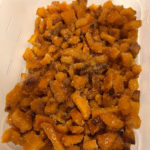
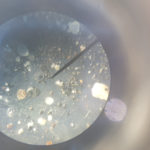
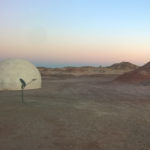

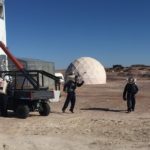

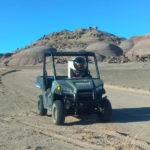
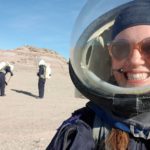
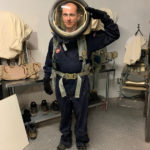
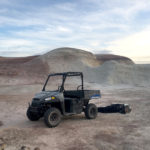

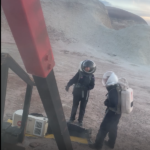
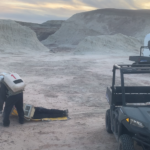
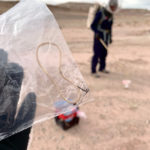

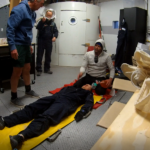
You must be logged in to post a comment.